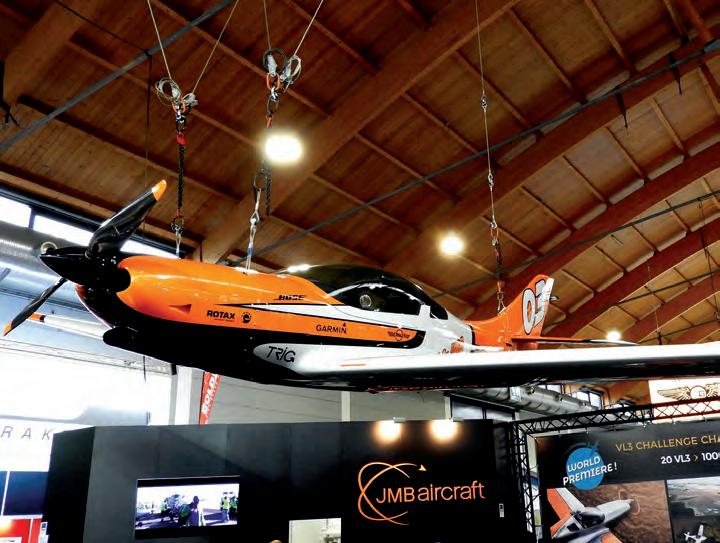4 minute read
LETTERS
Next Article
We are always pleased to receive your letters and feedback. Please email the editor at bfjjodel@talktalk.net
Another Norvigie
I was pleased to receive my copy of the September LAA magazine today and I am enjoying its varied content as usual. Thank you for all of the hard work you and your team have put into continuing its production throughout these difficult times. As I have a particular affinity for older aeroplanes, I was especially interested to see the article about the Spanhoe-based Norvigie G-CGWR. Your editorial and the article both describe it as the only example in the UK. There is, however, another example flying here, which was restored some time ago up at Wickenby, namely G-CDWE, but it is now based elsewhere. This is registered as an NC856 Norvigie and also has a current permit. I hope this information may prove helpful to you. Kindest regards, Tim Badham. Editor, Vintage & Classic VAC. (Thank you, Tim, and apologies to the owner for inadvertently ‘losing’ his aeroplane. Ed.)
To tell or not to tell?
Hi Brian. Like many other members I look forward to receiving the LAA magazine and usually, with a cup of coffee, read it from cover to cover. One section, Meet the Members is always an interesting read, as people’s flying experiences make good reading. However, in this month’s article, on page 58 the paragraph entitled: Have you had any ‘Iearned from that’ moments? in my opinion, should not have been published. I think it was rather poor judgement to make light of what was a very serious situation. If the LAA and the magazine reflect the high standards that are required while flying, then that particular event does not warrant being included in an otherwise excellent article.
Kind Regards, Lionel Moon.
Above There is a second Norvigie in the UK!
Hi Lionel, thanks for getting in touch. I am a great believer in the safety culture that aviation generally enjoys, and I know of at least one friend who was caught out in exactly the same way as Andy. Call it caught out, call it bad planning, call it stupidity, call it whatever you like; but it happened, and I believe it is better that it is out in the open so people can learn from it.
Another example was of a friend who was on an autumnal flight, and was returning to base late in the day when fog was starting to roll in. We all know, I hope, the risks of the temperature dropping towards the dew point as the sun gets lower in the sky, especially later in the year. My friend, and his pilot passenger certainly knew, but they continued and hoped there would be a suitable hole to descend through over their strip. However, they found themselves above cloud with no hole, no instrument training, and in a simple aircraft not IMC capable, so they called an airfield some miles away who said they were still in the clear. They had no choice but to head towards that airfield, uncertain that they would reach it with the fuel remaining. By sheer good fortune a hole appeared over the runway numbers of an airfield they knew en route, and they were able to drop down through it and land.
This incident did not get reported, and I do not doubt many similar incidents have happened, pilots being trapped above cloud, having a bad scare, but thankfully getting away with it.
Andy was honest about his error of judgement, and I thank him for being so. I also hope there are pilots out there who will take heed from these lessons, particularly as we approach the time of year when such incidents are more likely to sneak up on us. The answer is to act early, beat a hasty retreat and get back on the ground. Flying is an options game; you start with a fistful, but they slowly reduce as circumstances change; never allow yourself to get to the point where you have none left. Ed.
Polarised aircraft!
Brian, I was interested to read Ian Fraser’s article in the last issue regarding polarising sunglasses. He’ll forgive me for observing that this was something those of us of an age discovered a generation ago, when we first sported LCD digital watches. Remember those?
But of course, the other big ‘gotcha’ is that such lenses reduce or eliminate the flash of reflected sunlight from surfaces of a manoeuvring aircraft, which might be the first or only clue you will have to their presence. In gliding mode, I may want to fly towards them to share their lift, or otherwise fly away for separation, but either way I want to see them!
Brian Irwin.
Emergency First Aid
Hi Brian, I’m not a ‘Permit’ aircraft member, I fly PA28/C172 etc. but the LAA was hugely helpful when I needed to get an NPPL in order to keep flying. I have now moved onto a LAPL and PMD.
I’m afraid I can’t help with any of your training course ‘ideas to progress’, however I would attend an ‘Emergency First Aid skills’ course if there is one. Great Rally last weekend!
Best regards, John Webb.
Thanks John, this is a course I want to progress, so keep an eye out in the mag for maybe next spring. To date response for volunteers and ideas to bolster courses has been disappointing, you are in an exclusive group of two responders. I’d like to think there are a few more thinking of getting in touch! Brian. ■











